Pawscessories is reader-supported. When you buy via links on our site, we may earn an affiliate commission at no cost to you.
Learn more.
If you’ve ever seen your dog scooting their bottom along the ground, licking or biting at their groin area incessantly, then you may have wondered if they have a rash.
Rashes on a dog’s groin can be caused by a variety of things, from allergies to yeast infections. And they can be quite uncomfortable for your furry friend.
This post will discuss what causes these rashes, the most common symptoms to look out for, and the best ways to treat them fast.
Let’s jump right in.
Table of Contents
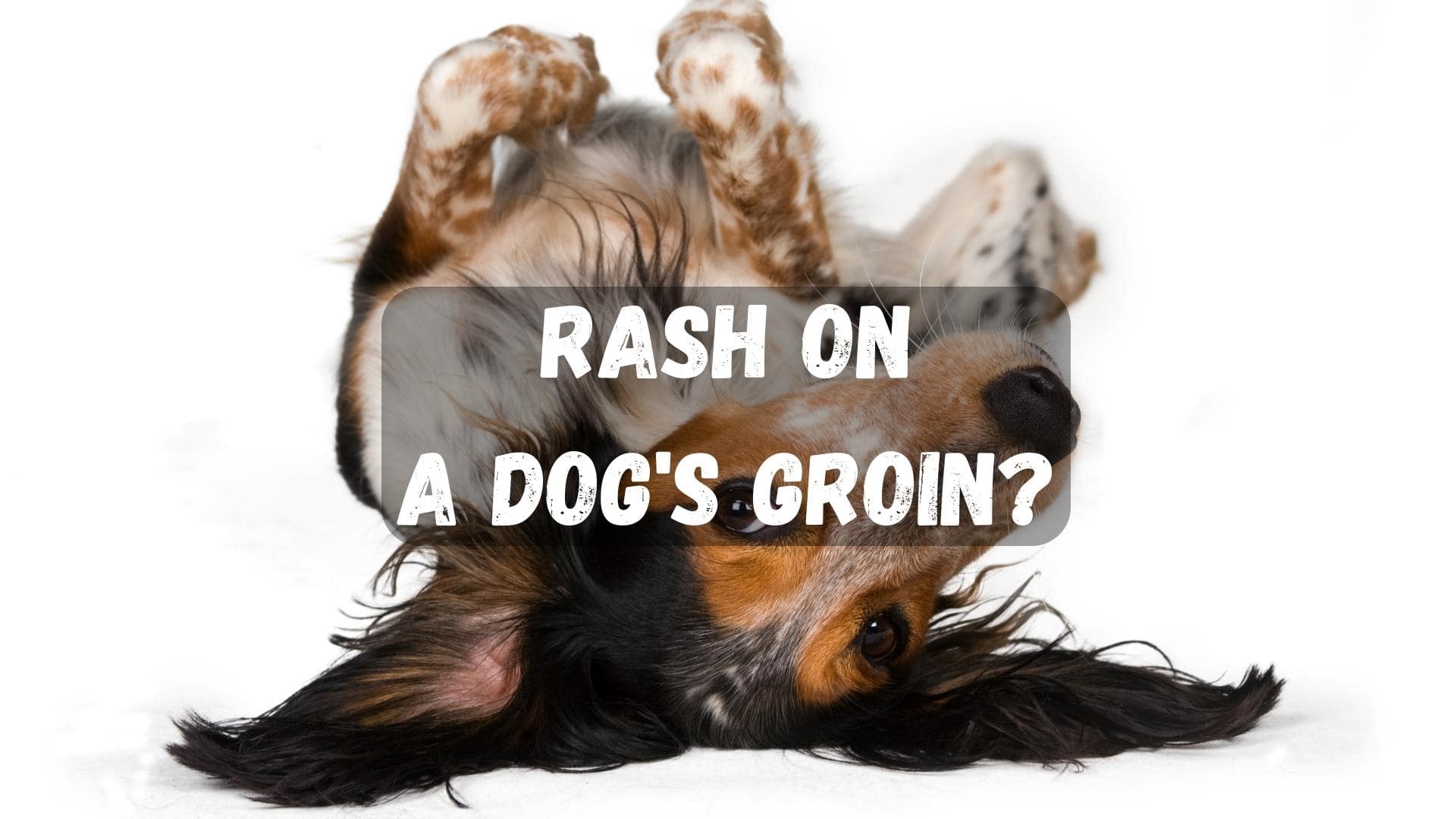
Types Of Rashes a Dog Can Get On Their Groin
1) Atopic Dermatitis
Atopic dermatitis is a common skin condition that affects dogs of all breeds. The most common symptom is intense itchiness, which can lead to secondary infections and hair loss.
While the exact cause of atopic dermatitis is sometimes difficult to pinpoint, it is thought to be related to an allergy to something in the environment, such as pollen or mold. Treatment for atopic dermatitis usually involves a combination of medication and lifestyle changes.
For example, baths with a mild shampoo can help to soothe the skin, and avoiding known triggers (such as pollen) can help to prevent flare-ups. In severe cases, oral medications may be necessary to provide relief.
2) Hot Spots
Hot spots are circular patches of irritated or infected skin that can be painful and itchy. They typically occur as a result of allergies, insect bites, or trauma to the skin.
Hot spots can quickly become infected if not treated properly. In some cases, dogs will lick or chew at the hot spot in an attempt to relieve the itch, which can further irritate the skin and lead to infection.
If you notice your dog scratching or licking excessively, check for signs of a hot spot. If you find one, clean the area with a gentle antiseptic and apply a cool compress to soothe the skin.
With proper care, hot spots will heal within a few days. However, if left untreated, they can become serious health problems.
3) Puppy Pyoderma
Puppy pyoderma is a bacterial skin infection that commonly affects young dogs. It is most often seen in puppies between the ages of six weeks and six months.
The bacteria enter through breaks in the skin, such as small cuts or insect bites. Once inside, the bacteria multiply rapidly, causing the affected area to become red, swollen, and painful.
The most common symptom of puppy pyoderma is a red, crusty rash on the skin. Other symptoms may include hair loss, itchiness, and bumps or pimples on the skin.
Puppy pyoderma can be very serious, and if left untreated, it can lead to secondary infections and even death. Early diagnosis and treatment are essential for preventing serious complications.
Fortunately, puppy pyoderma is typically easily treated with antibiotics.
With prompt treatment, your puppy can make a full recovery and will be back to their playful self in no time.
4) Flea Allergy Dermatitis
Flea allergy dermatitis (FAD) is a reaction that some dogs have to flea bites. Many people don’t realize that fleas can actually cause an allergic reaction in some dogs, but it’s a very real and potentially serious condition.
Dogs with FAD are hypersensitive to the proteins in flea saliva, and even a single bite can trigger a severe allergic reaction. Symptoms of FAD can include intense itching, hair loss, redness and swelling of the skin, and hot spots.
Untreated FAD can lead to secondary infections, as well as severe discomfort for your dog.
Avoiding fleas completely is often the best way to prevent the condition from developing in the first place.
There are many effective flea control products available, so if you think this is the reason for your dog’s groin rash, talk to your veterinarian about which option is best for them.
Things That Can Cause a Dog To Get a Groin Rash
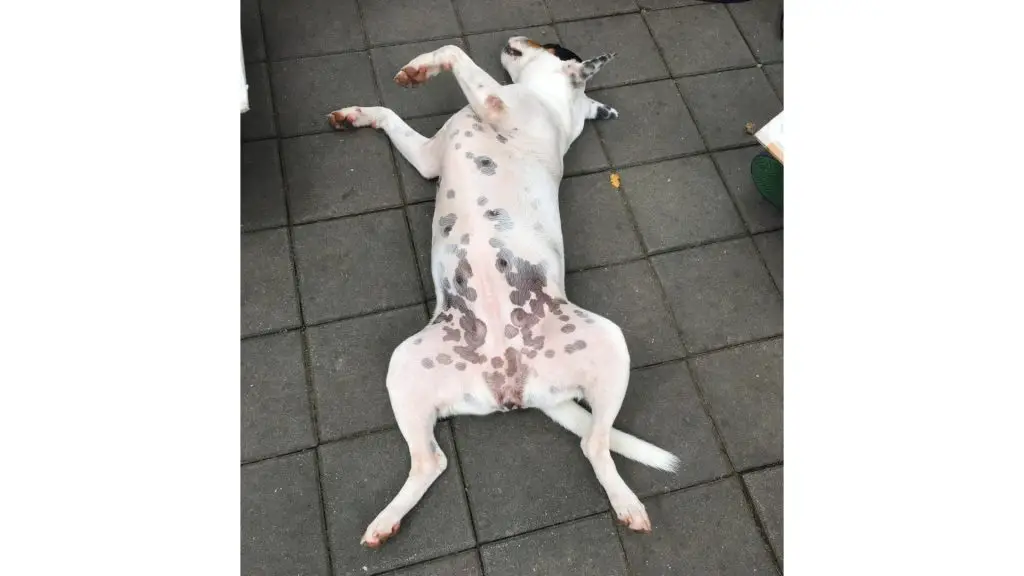
There are many different things that can cause a dog to develop a groin rash. Some of the most common causes include:
- Allergies
- Insect bites
- Trauma to the skin
- Bacterial infections
- Parasitic infections
- Hormonal imbalances
- Autoimmune disorders
- Bad diet
- Poor grooming habits
- Genetics
- Environmental factors
Any of these things can cause the skin to become irritated, inflamed, and itchy, which can lead to a rash.
If you’re unsure what’s causing your dog’s rash, it’s best to talk to your veterinarian. They will be able to help you identify the cause and develop a treatment plan.
Most Common Symptoms Of a Dog Groin Rash
A rash on your dog’s groin can show up in a variety of different ways. The most common is a red, itchy, inflamed area of skin.
However, there can be many different symptoms that can be associated with a dog groin rash. Some of the most common include:
- Itching
- Hair loss
- Redness and swelling of the skin
- Bumps or pimples on the skin
- Crusty or scaly patches on the skin
- Oozing or discharge from the affected area
- Bad odor
If your dog is experiencing any of these symptoms, they may have a rash.
Of course, it’s always best to consult with your veterinarian to be sure. They will be able to determine if your dog has a rash and the best course of treatment.
Are Some Dog Breeds More Likely To Get a Groin Rash?
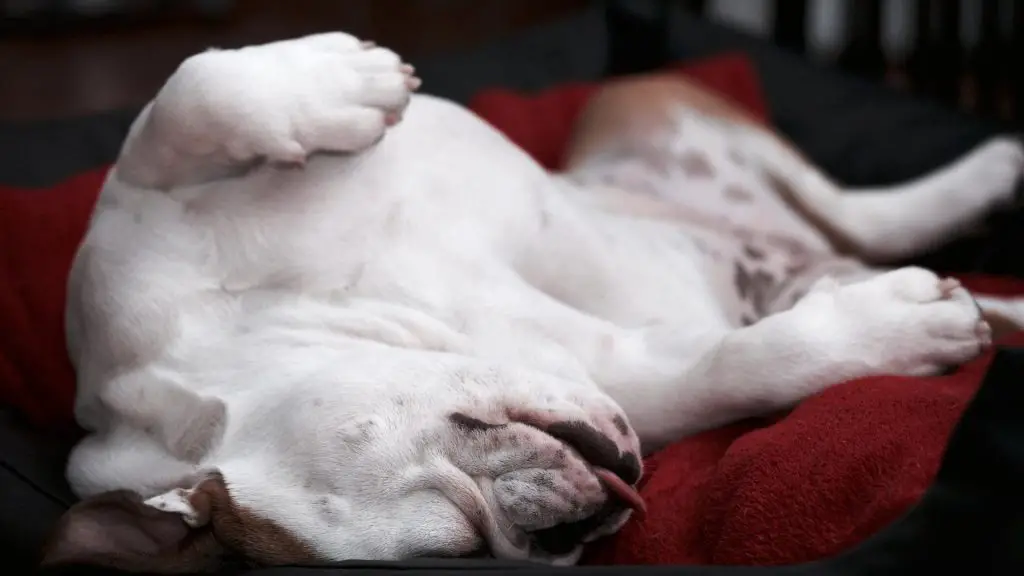
The truth is any dog breed can get a groin rash. Allergies and skin sensitivities are not isolated to a particular group of dog breeds.
However, some dog breeds are more prone to allergies and other skin sensitivities. This makes them more likely to experience a groin rash.
Just like with people, some are more sensitive to airborne allergens or foods.
Some dog breeds that are most prone to allergies and other skin sensitivities include:
- Golden Retrievers
- Labrador Retrievers
- Cocker Spaniels
- Bulldogs
- Poodles
- Shih Tzus
If you have one of these breeds, it’s important to be aware that they may be more likely to develop a groin rash. And how to properly treat a rash and best prevent them from getting one in the first place.
Of course, this doesn’t mean they will definitely get a rash, but it’s something to keep in mind.
Traditional Groin Rash Treatments
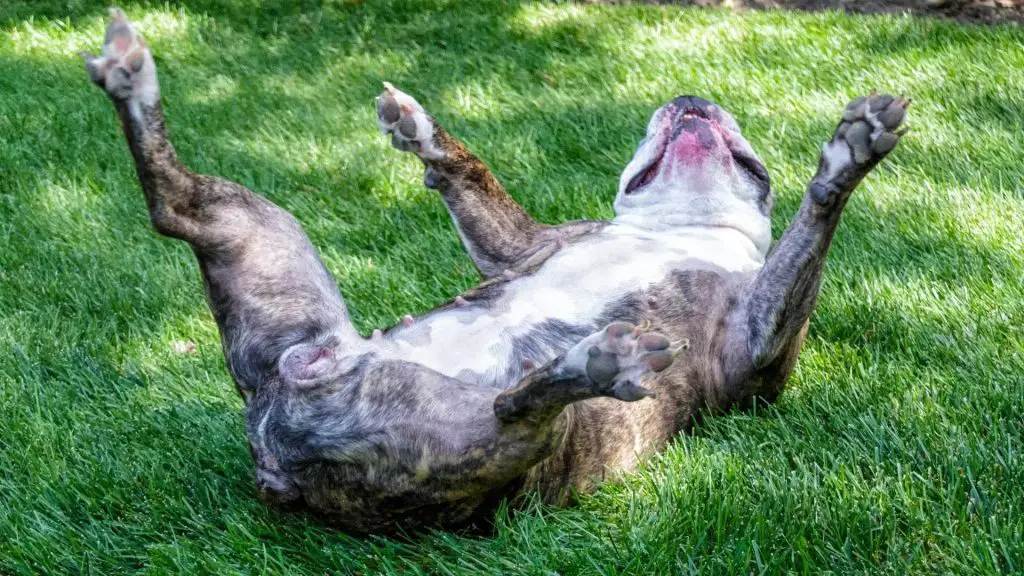
Medicated Dog Shampoos
If your dog has a mild groin rash, medicated dog shampoos can be a great way to treat it. These shampoos typically contain ingredients like oatmeal or aloe vera, which can help soothe the skin and relieve itching.
There are many different shampoos you can get that focus on relieving itchy skin, but it’s always a good idea to get a veterinarian’s recommendation. They will be able to suggest a good shampoo for your dog’s particular situation.
Anti-Itch Sprays and Creams
If your dog has a more severe rash, they may need something stronger than just a medicated shampoo. In this case, anti-itch sprays or creams can be helpful.
These products typically contain ingredients like hydrocortisone or phenol that can help relieve itching and inflammation.
As with medicated shampoos, there are many different products available. So, be sure to talk to your veterinarian about which one is best for your dog’s rash.
Oral Medications
In some cases, your dog may need oral medications to treat their rash. This is usually the case with rashes that are caused by allergies or bacterial infections.
Oral antihistamines can be helpful for treating allergic reactions. And antibiotics can be used to clear up bacterial infections.
Your veterinarian will be able to determine if oral medication is necessary and, if so, which one is best for your dog.
Home Remedies To Treat a Rash On a Dog’s Groin
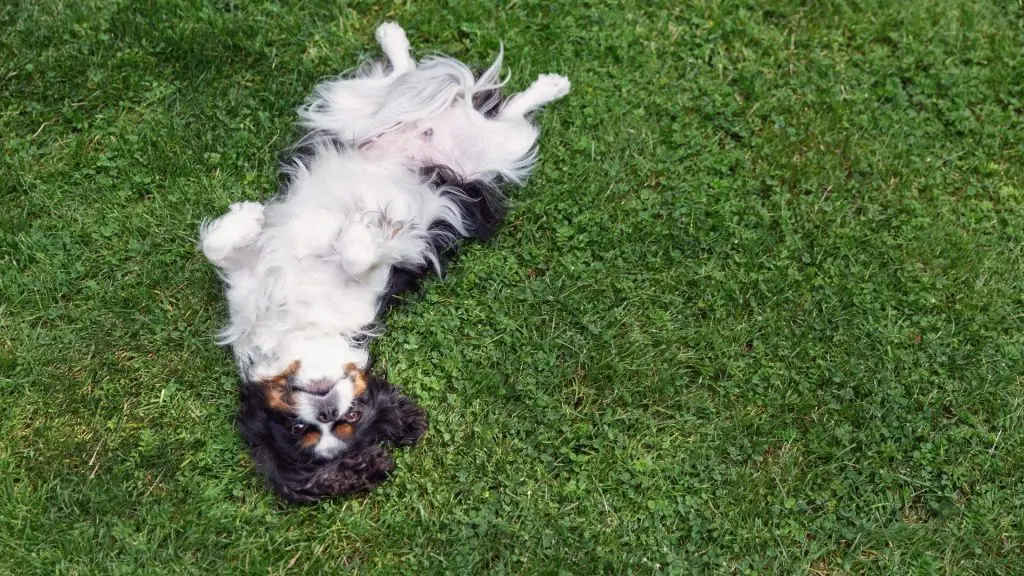
Elimination Diet
When a dog is allergic to something in their food, the only real way to find out what they’re allergic to is to do an elimination diet.
More often than not (but not all the time), when a dog has a food allergy, it’s to a certain protein in their food.
An elimination diet is when you isolate specific protein sources in your dog’s diet and try different food until their condition improves.
For example, if they are eating food where the primary source of protein is chicken, switch to a fish-based protein food. This way, when you keep everything else in their diet the same, you’ll be able to see if they improve.
If they don’t, it’s likely a different source. In which case, you’d simply try eliminating something else while keeping everything else the same.
The key to doing an elimination diet is to be patient and consistent. It can take weeks or even months to determine what your dog is allergic to. But, it’s worth it if it means finding a food that they can eat without having a reaction.
Coconut Oil
Coconut oil is a natural anti-inflammatory and can be helpful for treating rashes. It’s also a natural antibacterial, so it can help clear up any bacterial infections that may be present.
To use coconut oil, simply apply it to the affected area several times per day. You can also add it to your dog’s food. The recommended dosage is about one teaspoon per day per 20 pounds of body weight.
Vitamin A Cream
Vitamin A cream can be an effective treatment for rashes caused by allergies, hot spots, or other skin irritations. It’s a natural anti-inflammatory and can help reduce itching.
Vitamin A is a fat-soluble vitamin that is essential for healthy skin and coat. When applied to the affected area, it can help to soothe irritation and promote healing.
Vitamin A cream is available over the counter. It can often be found in the first aid aisle of your local pharmacy or on Amazon. If you are unsure whether vitamin A cream is suitable for your dog’s rash, talk to your veterinarian.
How To Prevent Your Dog From Getting a Groin Rash Again
The best way to prevent your dog from getting a rash again is to figure out what’s causing it and avoid that trigger.
If the rash is caused by allergies, you’ll need to do some detective work to figure out what they’re allergic to. Once you know, you can take steps to avoid that allergen.
If the rash is caused by a bacterial infection, you’ll need to make sure your dog’s vaccinations are up to date. And, if they go outside, be sure to keep them clean and dry.
Finally, if the rash is caused by hot spots or other skin irritations, you’ll need to take steps to prevent those from happening. This may include using a medicated shampoo, avoiding harsh chemicals, and keeping your dog’s skin and coat well-moisturized.
A few things you can incorporate into your dog’s daily life to limit their chances of getting a groin rash again are:
- Fish oils: Fish oils are a great way to keep your dog’s skin and coat healthy. They’re also anti-inflammatory, so they can help to reduce irritation if your dog does get a rash.
- Probiotics: Probiotics help to maintain a healthy balance of bacteria in the gut. This can be helpful for preventing skin infections, as well as other types of infections.
- Avoid too much variety in their diet: If your dog is prone to allergies, it’s best to feed them a limited ingredient diet. This will help to prevent any reactions from happening.
By taking these preventive measures, you can help dramatically reduce the chances that your dog experiences a rash again in the future.
When Should You Take a Dog To The Vet For a Groin Rash?
If your dog is experiencing a rash, it’s always best to consult with your veterinarian. They can help you determine the cause of the rash and recommend the appropriate treatment.
There are some instances where a trip to the vet is absolutely necessary, such as when:
- The rash is accompanied by other symptoms, such as fever or vomiting
- The rash is severe or seems to be getting worse
- Your dog is in a lot of pain
- You’ve tried home treatment for more than a week with no improvement
If you’re unsure whether or not your dog’s rash warrants a trip to the vet, it’s always best to err on the side of caution and make an appointment.
Final Thoughts
Rashes on a dog’s groin can be uncomfortable and frustrating for both you and your pup.
But, by taking some preventive measures and knowing what treatments are available, you can help to keep your dog’s skin healthy and rash-free.
Other posts you might find interesting:
Why Are My Dogs Balls Red/Pink? (Fully Explained!)
